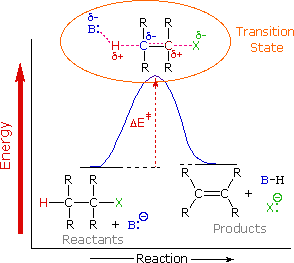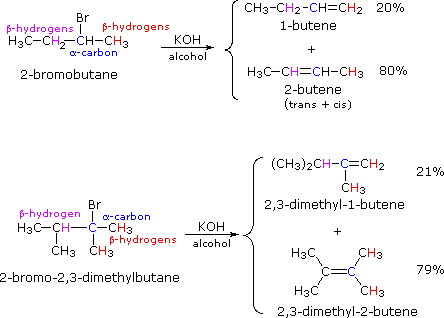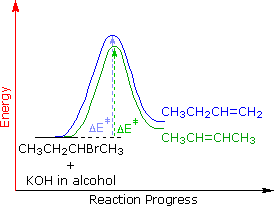E2 Elimination Reactions
- Page ID
- 1187
We have not yet considered the factors that influence elimination reactions, such as example 3 in the group presented at the beginning of this section.
(3) (CH3)3C-Br + CN(–) → (CH3)2C=CH2 + Br(–) + HCN
We know that t-butyl bromide is not expected to react by an SN2 mechanism. Furthermore, the ethanol solvent is not sufficiently polar to facilitate an SN1 reaction. The other reactant, cyanide anion, is a good nucleophile; and it is also a decent base, being about ten times weaker than bicarbonate. Consequently, a base-induced elimination seems to be the only plausible reaction remaining for this combination of reactants. To get a clearer picture of the interplay of these factors consider the reaction of a 2º-alkyl halide, isopropyl bromide, with two different nucleophiles.

In the methanol solvent used here, methanethiolate has greater nucleophilicity than methoxide by a factor of 100. Methoxide, on the other hand is roughly 106 times more basic than methanethiolate. As a result, we see a clear-cut difference in the reaction products, which reflects nucleophilicity (bonding to an electrophilic carbon) versus basicity (bonding to a proton). Kinetic studies of these reactions show that they are both second order (first order in R–Br and first order in Nu:(–)), suggesting a bimolecular mechanism for each. The substitution reaction is clearly SN2. The corresponding designation for the elimination reaction is E2. An energy diagram for the single-step bimolecular E2 mechanism is shown below.

We should be aware that the E2 transition state is less well defined than is that of SN2 reactions. More bonds are being broken and formed, with the possibility of a continuum of states in which the extent of C–H and C–X bond-breaking and C=C bond-making varies. For example, if the R–groups on the beta-carbon enhance the acidity of that hydrogen, then substantial breaking of C–H may occur before the other bonds begin to be affected. Similarly, groups that favor ionization of the halogen may generate a transition state with substantial positive charge on the alpha-carbon and only a small degree of C–H breaking. For most simple alkyl halides, however, it is proper to envision a balanced transition state, in which there has been an equal and synchronous change in all the bonds. Such a model helps to explain an important regioselectivity displayed by these elimination reactions.
If two or more structurally distinct groups of beta-hydrogens are present in a given reactant, then several constitutionally isomeric alkenes may be formed by an E2 elimination. This situation is illustrated by the 2-bromobutane and 2-bromo-2,3-dimethylbutane elimination examples given below.

By using the strongly basic hydroxide nucleophile, we direct these reactions toward elimination. In both cases there are two different sets of beta-hydrogens available to the elimination reaction (these are colored red and magenta and the alpha carbon is blue). If the rate of each possible elimination was the same, we might expect the amounts of the isomeric elimination products to reflect the number of hydrogens that could participate in that reaction. For example, since there are three 1º-hydrogens (red) and two 2º-hydrogens (magenta) on beta-carbons in 2-bromobutane, statistics would suggest a 3:2 ratio of 1-butene and 2-butene in the products. This is not observed, and the latter predominates by 4:1. This departure from statistical expectation is even more pronounced in the second example, where there are six 1º-beta-hydrogens compared with one 3º-hydrogen. These results point to a strong regioselectivity favoring the more highly substituted product double bond, an empirical statement generally called the Zaitsev Rule.
The main factor contributing to Zaitsev Rule behavior is the stability of the alkene. We noted earlier that carbon-carbon double bonds are stabilized (thermodynamically) by alkyl substituents, and that this stabilization could be evaluated by appropriate heat of hydrogenation measurements. Since the E2 transition state has significant carbon-carbon double bond character, alkene stability differences will be reflected in the transition states of elimination reactions, and therefore in the activation energy of the rate-determining steps. From this consideration we anticipate that if two or more alkenes may be generated by an E2 elimination, the more stable alkene will be formed more rapidly and will therefore be the predominant product. This is illustrated for 2-bromobutane by the energy diagram below. The propensity of E2 eliminations to give the more stable alkene product also influences the distribution of product stereoisomers. In the elimination of 2-bromobutane, for example, we find that trans-2-butene is produced in a 6:1 ratio with its cis-isomer.

The Zaitsev Rule is a good predictor for simple elimination reactions of alkyl chlorides, bromides and iodides as long as relatively small strong bases are used. Thus hydroxide, methoxide and ethoxide bases give comparable results. Bulky bases such as tert-butoxide tend to give higher yields of the less substituted double bond isomers, a characteristic that has been attributed to steric hindrance. In the case of 2-bromo-2,3-dimethylbutane, described above, tert-butoxide gave a 4:1 ratio of 2,3-dimethyl-1-butene to 2,3-dimethyl-2-butene ( essentially the opposite result to that obtained with hydroxide or methoxide). This point will be discussed further once we know more about the the structure of the E2 transition state.
Contributors
- William Reusch, Professor Emeritus (Michigan State U.), Virtual Textbook of Organic Chemistry


